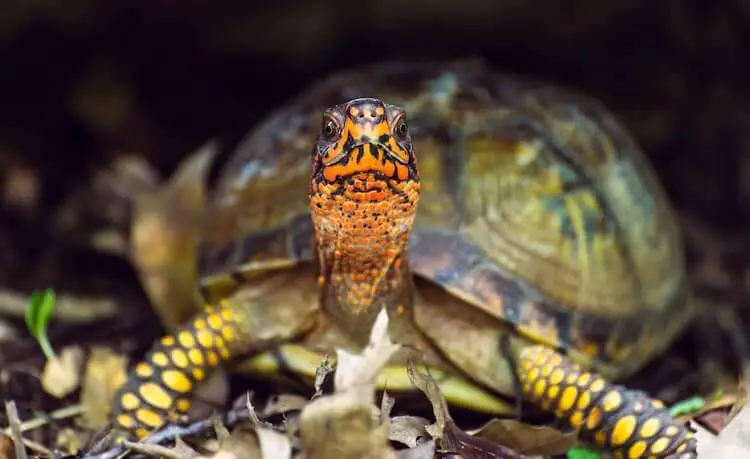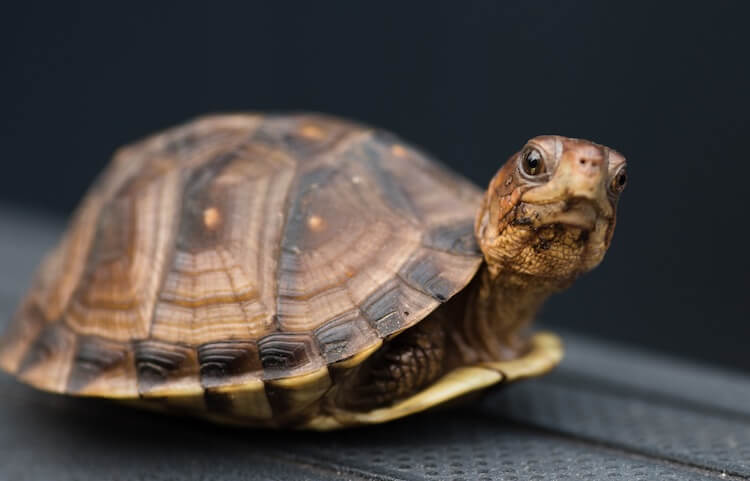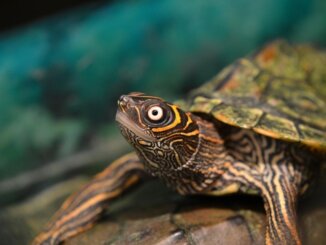Looking to bring a shelled-pet into your home? The Box Turtle is a friendly, inexpensive reptile that you and your family can form a bond with for many years to come.
There are several species found throughout both North America and Asia, and they are one of the most popular turtles in America.
Small, easy-to-handle, with a relatively easy diet to feed, they make a great first turtle for many owners. They are also very hardy animals and have relatively few health issues.
If this sounds like the ideal pet for you, read on to learn how to care for them.
What Is A Box Turtle?

The Box Turtle has several species and subspecies that are spread throughout Asia and North America.
Indochinese boxes can be found throughout Vietnam, Laos, and China (Hainan Island). In 2002, this species was classified as endangered due to deforestation, hunters, and being sold in markets.
There are two species and eight subspecies in North America:
- Towards the eastern half of the United States, you will find the Terrapenes carolina species which includes the following subspecies: The Three-Toed, Gulf Coast, Florida and Eastern Box Turtle.
- The Terrapene ornata species has the Ornate and Desert subspecies.
For some hobbyist herpetologists this species of turtle can be high-maintenance when compared with beginner reptiles. They do require some lighting and high temperatures (which we will discuss later on). However, with some simple guidance on diet and habitat, and a daily husbandry routine, caring for your turtle becomes more normal and easy.
This reptile likes soaking themselves in water and spending time outside on a sunny day. They are natural omnivores, eating a wide variety of invertebrates, fruits, and vegetables. Known for being a relatively hardy animal, they can live to 50 years old.
One of the many reasons beginners choose to adopt this species is because they are usually tame, which makes them easy to handle. They also tolerate each species within their vivarium, so you can keep more than one!
They are small pets, reaching just six inches long, however, they can come in a large variety of patterns, including black, brown, olive, or yellow spots and stripes.
| Quick Facts | |
|---|---|
| Scientific Name | Terrapene carolina, Terrapene ornata, Cuora galbinifrons |
| Price | Less than $50 |
| Lifespan | 30-50 years |
| Diet | Variety of worms, insects, fruits, and vegetables |
| Tank Size | 20-gallon aquarium |
| Humidity & Temperature | 70℉-80℉ with a high humidity |
| Popular Alternatives | Red-Eared Slider, Razor-Backed Musk Turtle, Painted Turtle |
How To Care For A Box Turtle
Most are found in relatively warm environments (e.g. Vietnam, Laos, and China). They like forested areas with lots of shade and some patches of light. In forests they are commonly found amongst wet leaves, logs and stumps around the edge of ponds.
Their ideal day is a warm, sunny one, where they will spend it sunning themselves and cooling off in the shade. If you choose to take your pet outside, make sure to supervise them!

Indoor Box Turtle Habitat
For such a small animal, they require a large amount of space in your home. A 20-gallon glass aquarium works well for them, but bigger sizes of 30 or 40 gallons are better.
Because Juveniles are not substantially smaller than their adult size (depending on their age), they may be able to live in the same size enclosure.
In their tank, your turtle will need lots of leaves and logs to hide in. This will help to replicate their natural environment. They will also need a shallow pool of water to soak themselves in. The water should be no deeper than the turtle’s chin because, unlike most turtles, Box Turtles cannot swim. They will drown if they cannot make an easy escape.
Lastly, a wire barrier (rather than a cage hood) can be placed at the top of their tank. This will prevent easy escapes whilst giving you easy access to the inside.
Lighting and Heating
This species loves to have mostly shade, but they also enjoy the occasional bask.
Logs and plants will provide plenty of shady areas in your tank, while a 75-100 watt bulb can illuminate the rest of it. This light can serve as a heat source too (as long as the temperature of the rest of the room is relatively warm).
A UV light is the best choice as it will stimulate Vitamin D production.
Turtles should stay on a normal routine of 12 hours of daylight and 12 hours of darkness. This is especially true in the winter if you do not want them to hibernate.
Tank temperatures should be kept between 70℉-75℉ at night and 80℉-85℉ during the day. Keeping the room between 70℉ and 80℉ will help maintain these temperatures.
The humidity in the tank should be kept high too. Use a humidity gauge to measure and ensure it stays around 80%. If you provide a suitable pool of water for your turtle, this will naturally help to keep the humidity high. The tank can also be misted if humidity levels get too low.
Substrate
Many owners choose to use newspaper, carpeting, straw, or hay for a substrate (and they will all work just fine).
Newspaper makes an especially good choice for novice or first-time owners because it’s easy to clean up. Substrate should be spot cleaned daily and changed out every week or two. Cleaning your tank should take place one every one or two weeks. When cleaning your tank, all substrate and any dead leaves or uneaten food should be removed.
The best choice of substrate is wood chips (ideally alfalfa pellets). Wood chips allow for your turtle to burrow.
Soil, sand, and gravel should not be used as they can cause intestinal blockage if ingested.
| Tank Tips | |
|---|---|
| Tank Type | 20-gallon glass vivarium |
| Lighting | 75-100 watt light bulb, UV bulb |
| Best Substrate | Alfalfa pellets |
What To Feed A Box Turtle

Box Turtles are omnivorous reptiles. They eat a wide variety of things in the wild:
- Apples
- Beetles and other insects
- Blackberries
- Earthworms
- Mushrooms
- Slugs
- Snails
- Strawberries
- Spiders
This diet varies with the season and their habitat. The Box Turtle will use their strong jaw to capture and crush their prey before swallowing.
They are known to eat several times a week and are not usually picky, but in captivity they may favor some foods over others.
In captivity, you should feed your turtle a mostly carnivorous diet. Only 30% of their diet should be fruits and vegetables. Of this 30%, more vegetables should be fed than fruit.
Adults should be fed three times a week, while juveniles should eat everyday. Juveniles should also have a higher proportion of meat when compared with adults. A meat diet can consist of some slugs, caterpillars, hornworms, earthworms, snails, spiders, insects, and even an occasional pinky mouse.
They should eat small portions of leafy greens, shredded squash, carrots, sweet potatoes, apples, tomatoes, blackberries, strawberries, sour cherries, plums, pears, grapes, mulberries, or cantaloupe.
You should continually feed your pet a variety of greens as Box Turtles need a variety. If they don’t like a particular food, feed it several times and they may start to like it (making sure to remove old, uneaten food daily).
All foods should be washed and cut into pieces before being fed to your turtle. Food should also be dusted with a calcium supplement. Vitamin A is commonly deficient, so you can feed vitamin A-rich food or use supplements.
Finally, they should always have access to clean water, both for drinking and for soaking. This water should be easily accessible and always clean.
How To Keep Them Healthy

Common illnesses in the wild with this species are far are less common in captivity. Trauma, maggot infestations, and shell fractures (as they are often run over by cars) shouldn’t happen to turtles in captivity. Swelling may be a sign of trauma, and the best thing to do if this happens is to take your turtle to the vet. Maggot infestations will only occur if currently open wounds are not kept clean (i.e. poor husbandry).
In captivity your turtle is more likely to get:
- Internal parasites
- Metabolic bone disease
- Ear infections
- Egg retention
Internal parasites are easily treated with basic medication from the vets.
Metabolic bone disease is an illness that many reptiles are susceptible to. It is hard to diagnose in turtles, but can be easily avoided by using calcium supplements during feeding.
Other illnesses to be aware of as first time owners are middle ear infections and egg retention. Egg retention may occur if an improper laying bed is presented. If this happens your turtle may need oxytocin injections from the vet.
Most if not all of these illnesses are the result of poor husbandry and can be easily avoided.
| Signs They Are Healthy | Sickness Symptoms |
|---|---|
| Active and alert | Discharge in the eyes or nostrils |
| Quick to retract limbs if startled | Dragging their shell |
| They should feel heavy (like a glass of water) | Feels light in weight (like the shell is empty) |
| Clear mouth, nostrils, and eyes, and a strong, hard shell | Excessive mouth mucus |
Lifespan
This species is an extremely hardy reptile and can live for a very long time.
Box Turtles generally live for between to 30-50 years, but some turtles have lived as long as 100!
They are generally very healthy, and most if any problems come from poor diet or incorrect husbandry. The most common disease they suffer from is a vitamin A deficiency (i.e. hypovitaminosis). Signs of this disease include anorexia and secondary respiratory infections, and these often arise from a poorly balanced diet.
Make sure you feed vitamin A-rich foods like orange vegetables to prevent hypovitaminosis.
A poor diet is also the cause of other illnesses, such as starvation.
Box Turtles should not be over or underfed, and their weight should be checked regularly. Signs of starvation include dehydration, anorexia, and weakness. You can rehydrate a turtle by allowing them to soak for several hours, but they may also need to be tube-fed in a veterinary hospital if they are very starved.
Handling Advice
Keeping good hygiene is important for both you and your turtle. So before any handling takes place, start by washing your hands.
How To Handle Your Turtle
- Before deciding to handle, make sure they are not in the middle of sleeping or eating, and you should consider if they are in the mating season.
- Use both of your hands and pick up your turtle from both sides of their shell.
- Don’t squeeze your turtle, but make sure they do not wiggle out of your hands while they are high in the air.
- Don’t pick up your turtle by the limbs or turn them quickly.
- Box Turtles, although docile, do best when handling is limited to checkups and cleaning.
Sometimes Box Turtles urinate if they are startled when they are picked up. This normally occurs because they weren’t expecting to be picked up.
They have a good memory. It isn’t unheard of for them to come running to you if you present them with food during handling. They may even tame down to the point where you can feed them out of your hand.
Usually very docile, you shouldn’t expect them to bite or snap, though you shouldn’t handle them when they are sleeping.
Typical Behavior

In their natural habitats, Box Turtles are rather active little creatures. They are active during the day and will have periods of activity alternated with periods of rest.
This turtle is not territorial and is very tolerant of other species of all ages. This species is usually very tolerable of others and can be housed together with little problems.
Fighting is very rare among them, if any problems occur, it may happen if they are sharing the same food dish, or between two males during mating season, so be wary of these moments. They have little in the way of communication:
- An aggressive turtle may snap at another.
- A submissive turtle will pull its head into its shell to protect itself.
In an enclosure, your box turtle will also have periods of activity and rest. They may spend their rest periods basking, soaking, or hiding in a log.
Hibernation Behavior
Box Turtles do hibernate. This aspect of their care can be more difficult to manage for new owners.
You will notice they become sluggish in October and then hibernate for anywhere between three to five months. They like to hibernate in loose ground debris, and they do not eat very much immediately following this hibernation period.
If you choose to let them hibernate, make sure they are in a good, healthy condition before you change their habitat. In mid-fall, when your turtle begins to seem sluggish, withhold food for two weeks to allow them to finish digesting.
After two weeks, you should decrease the tank temperature to 60℉-70℉, and then to 45℉-60℉. Temperatures above 60℉ are too warm to hibernate in, but do not let the temperature get too cold, or they can get sick.
Give your turtle about a foot of potting soil with several inches of shredded newspaper on top to hibernate in.
Appearance Of A Box Turtle

This species of turtle does not have any true sexual dimorphism, but most males tend to have red eyes, while females tend to have brown eyes. In males, claws may be stout and curved, while females have slender, slightly curved claws.
Their color is variable depending on the species or subspecies.
Some may have a lemon-yellow or olive-yellow head, while their shell may be brown to olive-brown or black in color. Some have black triangular markings with a brown or olive triangle behind the eye, and some may also have a big dark spot on their underside. They may have red or light brown on their spines or three longitudinal stripes.
Size
Box Turtles should be finished growing by the time they turn 15. Adults are only about five inches in size and will weigh 400 grams on average.
They are small animals and grow very slowly. Females usually reach sexual maturity at eight years old, while males tend to reach sexual maturity around seven.
| Age (years) | Size (inches) |
|---|---|
| 3 | 2 |
| 5 | 3 |
| 8 | 4 |
Baby Box Turtles

At birth they are only about one inch long and will weigh 7 to 10 grams (talk about a tiny turtle!)
After hatching, sometimes they will try to hibernate without eating (if it is late enough in the season). If you do not want them to hibernate, make sure they get plenty of heat and light. Babies can be shy about eating, so be patient if at first they do not touch the food you give them. They should eat daily.
The mating season takes place right after hibernation in April, and the egg laying season takes place in early June to the middle of July. The eggs have an incubation period of 50-90 days, depending on the temperature of the soil they are laid in.
Eggs should be incubated at 80℉ in vermiculite and water after the female lays them.
The hatching time is dependent on the temperature of the soil:
- Higher temperatures result in an earlier hatch, and they also lead to a higher number of females.
- Lower temperatures make it more likely for the hatchlings to be male.

How Much Does A Box Turtle Cost?
Purchasing this pet is relatively inexpensive as far as reptiles go. They are readily available in pet stores and will cost between $25-$50 (they can be more expensive from a private breeder or distributor).
If you can, try to purchase captive-bred, as wild-caught can come with illnesses or trauma.
Care Guide Summary
| Pros | Cons |
|---|---|
| Docile and tame | Require a wide diet range |
| Inexpensive to adopt | Can have many health issues from poor husbandry |
| Hardy and live for a long time | Hibernation may be difficult to manage |
Box Turtles have very specific care requirements that require a robust husbandry routine. However this management is relatively simple for first time owners after a few weeks.
They should be fed a variety of foods a couple times a week and require a regular tank cleaning routine. Although it may take some getting used to, this routine is absolutely manageable by a herpetologist of any level, including beginners.
Adopting this species is a long commitment. Any owner must be prepared to care for their turtle for several decades.
Other beginner turtles that may not live quite as long and are equally beginner friendly include the Red-Eared Slider, Razor-Backed Musk Turtle, and the Painted Turtle.
Box Turtles are tame and inexpensive, and many turtle owners form a lifelong bond with their pet. If this is the one for you, feel free to let us know below.





I own a box turtle and her name is Penelope, she is very curious and loves to roam everywhere. I have no idea how old she is, but she is less then half the size of an adult and can fit in my palm with her diggy nubs hanging out between my fingers. I call her cute little claws diggy nubs she eats mostly bugs and is very picky.
Awe she sounds sweet. Good luck with her. Make sure she gets a check up every year from a reptile vet. Good luck to you both!
For the past 6 yrs a wild box turtle has come to visit me several times a yr. She loves to just sit on my lap. She lives in an environment where there is a lot of flooding. Since they’re not good swimmers, I worry about her. Would it be safe for her if I give her a home with me?
I had a similar thing happen. My dog found a box turtle in our backyard and it seemed to continue to visit. It floods heavily here too and I was concerned for him. I did create a home for him in an outdoor enclosure for the Summer and as it began getting colder, I was afraid he’d be in danger. Now, Donatello, as I named him, lives in a 20 gallon tank in my home. He loves meal worms, apple, and green beans! He enjoys resting under his log hut I got for him and seems to be very happy and healthy! I just love him! 🥰
Hello guys my name is Abby we found a box turtle in the wall and eastern box turtle about 5 inches long and I’m pretty sure it’s a female her eyes are brown could anybody tell me how I can set up a tank for this turtle it’s for my son and what all I need to get any tips guides anything anything y’all can tell me would help although I think it’s a girl he’s done name to Michael Angelo
To set up an ideal but easy to maintain Box Turtle enclosure, you need to get an aquarium (minimum 20 gallons), and put newspapers (or hay, wood chips) on the bottom to form a substrate. Insert a water dish, it can be quite large but no deeper than her chin. Put leaves, branches, logs, and a couple of rocks inside the tank, so as to create shaded areas and hiding spots. Ideally, you then need to get a thermometer and an hygrometer (you can easily find a thermo-hygrometer online). Keep in mind temperature should be around 80-85°F in the daytime, and humidity should be at around 80%. If you can give your Box Turtle some direct sunlight (not through her enclosure glass), you do not need a UVB bulb. Otherwise, buy one that is of the appropriate power and that is placed at the right distance from your animal.
I also found one about 4 years ago only has 3 legs and so sweet!!!She is about the size of the palm of my hand love her she loves dried crickets too!!!she likes walks down the walkway and when the first year we fount her she was in our fairy garden and she ran off, and came back a year lates and then we put her in a tank and she is a great swimmer also loves water!!!best turtle ever and we named her Shelly!!!🐢😍☺️
They are incredibly fun and affectionate animals! I’m happy to read she could survive, swim and thrive with only 3 legs. Since you found her in the wild, make sure you give her some nature time outside of her tank once in a while.